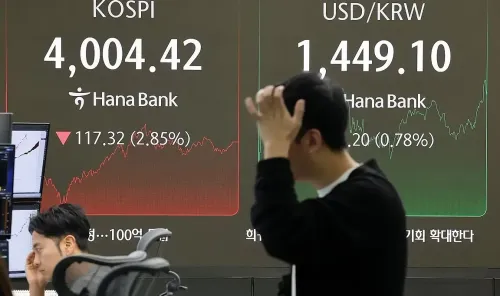How are Indian Markets Resilient Amidst Rs 1.5 Lakh Crore Sell-off by FIIs?

Synopsis
Key Takeaways
- Indian markets show resilience amid foreign sell-offs.
- Domestic institutional investors have invested over Rs 4 lakh crore this year.
- DII inflows reached 2.2 percent of Nifty market cap, highest since 2007.
- Retail investors continue to invest significantly in equity mutual funds.
- Geopolitical uncertainties are affecting foreign investment strategies.
Mumbai, Aug 14 (NationPress) Despite the ongoing sell-off of Indian equities by foreign institutional investors (FIIs), the stock markets are demonstrating remarkable resilience, thanks to substantial purchasing from domestic institutional investors (DIIs) and retail investors.
The secondary market witnessed an outflow from FIIs in 2025, marking the highest foreign selling activity in India’s market history. In contrast, DIIs have infused over Rs 4 lakh crore into the Indian stock market this year, the most significant cash market inflow for this category during the initial seven months since 2007.
Within the first seven months of 2025, DIIs contributed to over 80 percent of total inflows for 2024, offering critical support to the market. The year-to-date inflows from DIIs in 2025 reached 2.2 percent of the average Nifty market capitalisation, representing the highest level since 2007.
This indicates a substantial rise from 1.4 percent in 2024 and is a significant improvement over the 0.6 percent recorded in 2023.
Additionally, Indian retail investors have shown unwavering confidence, pouring a remarkable Rs 427 billion ($4.9 billion) into equity mutual funds in July. This month saw equity mutual funds experiencing the highest inflow, even as foreign funds withdrew $3 billion during the same period.
According to NSDL data, FIIs have net sold over Rs 1.5 lakh crore in the secondary market year-to-date, surpassing all previous annual records. Analysts attribute this sell-off to slowing corporate earnings, unattractive valuations, rising geopolitical uncertainties, and comparatively lower valuations in international markets.
Markets in the US, China, and Europe offer cheaper valuations and potentially higher returns in the near future. Although India is the fastest-growing major economy, current geopolitical uncertainties have prompted portfolio managers to shift from a “buy-and-hold” strategy to tactical asset allocation.
Concerns over trade agreements with the United States and a potential extension of US-China negotiations are affecting foreign institutional investment flows. Indian investors are awaiting the meeting between US President Donald Trump and Russian President Vladimir Putin on August 15, as a positive outcome could alleviate tariff-related uncertainties.









